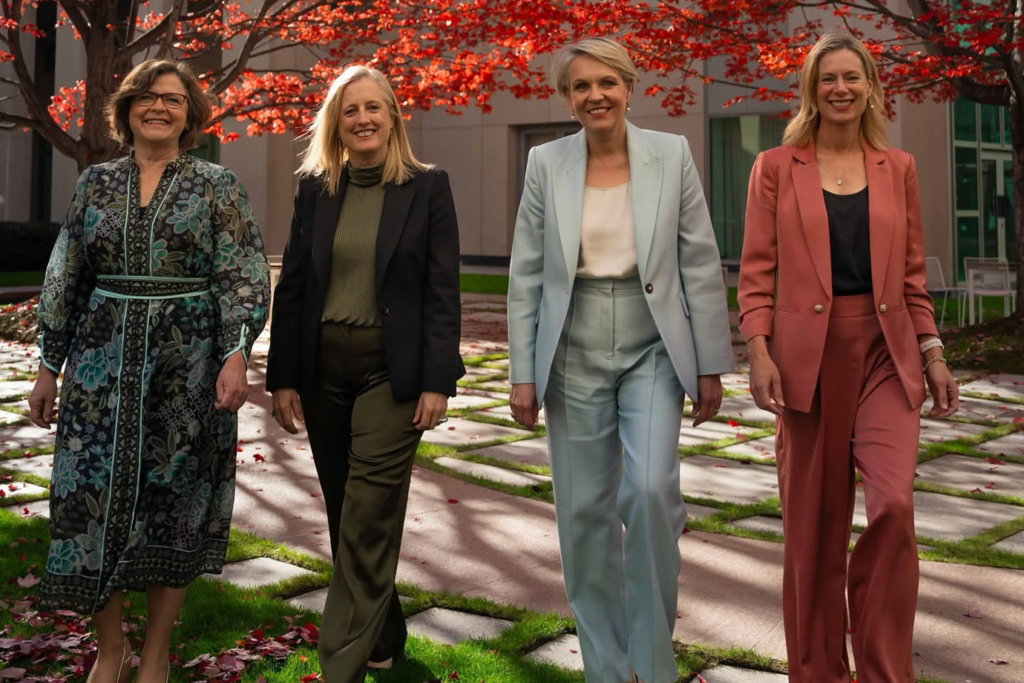Labor’s thumping electoral success is a triumph of strategic gender equality advocacy and transformation that has changed not just the Labor party, but the entire parliament.
Labor’s staggering 94 seat win in the lower house of Parliament is for the first time dominated by women. Of the 16 new seats secured by the ALP, 56 per cent were victories powered by Labor women candidates, including the sensational unseating of two male political leaders – Peter Dutton, leader of the Coalition (defeated by Labor’s long-term candidate for Dickson, Ali France) and the Greens leader Adam Bandt (defeated by Sarah Witty, a first-time Labor candidate in the seat of Melbourne).
Almost a decade ago, the federal Labor Party set a final ambitious gender target to guarantee 50 per cent of all candidates preselected by 2025 were women.
Not only did it achieve its affirmative action gender quota ahead of time, it has also reshaped the parliament to better reflect our community in ways far exceeding the expectations of the intergenerational faceless femmes who championed reform despite the opposition of Labor’s faceless men.
Progress towards 50/50 in the ALP was a journey beautiful for its persistent incrementalism. Though Labor feminists always had full gender parity in their sights, success was achieved by adopting planned, strategic progression towards the end goal. Targets were first set at 30 per cent in 1994 after a grassroots campaign orchestrated by woman across Labor’s factions. When that target was reached, women across the party campaigned again for the targets to be lifted to 40 per cent, this time with the support of newly formed EMILY’s List Australia, an independent feminist political organisation helping elect progressive pro-choice women to parliament.
In 2015, when the target was again lifted to 50 per cent, I had a front row seat, as EMILY’s List Australia’s National Convenor a role job-shared with then Labor Senator for South Australia, Anne McEwen. Although there were pockets of internal resistance to the target being lifted – Labor men worried about the security of their current and future roles – the final vote on the conference floor was unanimous. The beauty of persistent incrementalism is that it had built a sustained, cross-factional commitment to gender equality – championed by both men and women – as a key to electoral success.
The 50 per cent rule change also ensured that the target was applied to both winnable and unwinnable seats. This prevented women candidates being relegated to marginal electorates Labor had little hope of securing, while Labor men had a fast track to safe seats from which to build long careers and position for leadership. Labor feminists mastery of the rule changes ensured greater equality across all safe, marginal and unsafe seats.
The impact of Labor’s gender equality project can be seen across the Parliament. Labor’s Caucus is gender equal and so is the newly appointed Cabinet. The ‘teal’ independents are women dominated, Greens women are jockeying for the leadership and in an acknowledgment of how much work they need to do the Coalition has for the first time in its history elected a woman leader in Sussan Ley.
The Coalition has paid a steep price for ignoring the evidence of gender equality and strategies proven to achieve it. After years of pillorying Labor women as unmeritorious #quotagirls, denying their own women opportunities to overcome disadvantage, conservative women in once safe Liberal seats have abandoned them, delivering entrenched wins to ‘teal’ independents & the ALP – mostly women. Warringah, Kooyong, Bennelong – these were jewels in the Liberal Crown that have fallen to independent women MP’s due to patriarchal hubris.
Tony Abbott, who once said EMILY’s List Australia was, “arguably Labor’s biggest faction” like it was an insult, is particularly at fault for championing a culture of misogyny during Julia Gillard’s Prime Ministership, including famously standing in front of a “Ditch the Witch” sign at a public rally. A generation of young girls inspired by Gillard’s Misogyny Speech became first time voters at this election. Many more will be enfranchised in three years time. The spectre of Abbott loomed large over Dutton’s campaign – he was present on election night and his former Chief of Staff, Peta Credlin, continues to beat the drum for Trumpian style, anti-woke politics from her pulpit on Sky News.
Sussan Ley has her hands full exorcising the anti-woman demon that Abbott and Credlin have looped about the Coalition’s neck.
Meanwhile, Labor is taking what it learnt about gender equality internally into public policy. Prime Minister Albanese has elected a powerhouse of women MP’s to shepherd through its Working for Women economic policy agenda and navigate delivery of women’s health reforms. Basking in the autumn sunshine yesterday, Minister for Women, Finance, Public and Government Services, Katy Gallagher, Minister for Social Services, Tanya Plibersek, and assistant ministers, Ged Kearney and Rebecca White, looked like the feminist, pro-choice marvel team of my dreams.
It is enormously satisfying, after so many years supporting strategic change for gender equality, to bear witness to its success. We can now prove that gender equal leadership is electorally successful in the same way that we can show it delivers better financial outcomes for business and is effective protection against corruption and fraud. These things matter to our parliament and to future progress for our country.
There is much for other Australian industries to learn from Labor’s transformation. A once male dominated bastion, the labour movement has been changed for the better, making it stronger and more capable of meeting the challenges of the next century. Industries of the fourth industrial revolution – clean energy, advanced manufacturing and digital and technology – need to bring women to the heart of strategy, design and delivery, too. Women cannot be left in to carry the care economy, men are needed there too.
Of course, gender equality is never won and done. It requires consistent vigilance & a persistent commitment to gender-based power-sharing. Many of the post-election hot-takes have failed to acknowledge the significance of gender equal leadership on the Federal Election.
There is still a yearning, in some areas of the media, for a return to individualistic patriarchal explanations of Labor’s success. Dennis Shanahan’s painful praising of Albo in The Australian, seeks to position the PM as a hero-leader of Hollywood Central Casting, rather than a captain of a gender equal team. And somewhat surprisingly in the Saturday Paper, Jason Koutsoukis, with help from a few pale stale male Labor insiders, sought to frame the election win through the lens of men-gods, this time with Labor’s National Secretary, Paul Erickson, as the mastermind of victory.
But just as Erickson was not solely responsible for birthing his first child on the campaign trail (as some papers would have you believe), nor was he the boy-genius behind Labor’s win. There is no doubt that his partner in life and mother of their child, long term EMILY’s List member Dimity Paul, an outstanding and clever party apparatchik in her own right serving in the Albanese Government as Chief of Staff to Annika Wells, had more than a little influence on the outcome. Along with thousands of campaigners – of all genders. Gender equal leadership has powered Labor’s success and transformed the Parliament. Now it will power the nation.
Feature image: Ged Kearney, Katy Gallagher, Tanya Plibersek and Rebecca White. Credit: Ged Kearney, Facebook.
Support Women’s Agenda! We are 100% independent and women-owned. We’re covering the Federal Election from the perspective of what matters to women, and always keeping the issues that matter for women on the daily agenda. Foundation memberships are just $5 a month.
Bonus: you’ll receive our weekly editor’s wrap of the key stories to know every Saturday.


